Your First Basic V Neck Crochet Sweater is a free and easy crochet pattern that is made to measure, size inclusive and designed to be intuitive and beginner friendly.
As a blog that is dedicated to creating modern crochet patterns for beginners, we always try to design our patterns to be intuitive, simplified and beginner friendly. So when we designed and wrote Your First Crochet Beginner Sweater … it was great to see such a huge response from courageous crocheters, who wanted to take their first step towards crocheting modern garments.

We are trying to keep all our crochet patterns free for everyone, when you access them online. We meet the costs of running this website through coffee donations at https://ko-fi.com/kiksandjackcrochet and ad revenue. When you buy us a cup of coffee, you buy us a cup of motivation. Thank you for keeping us motivated and inspired every day to keep designing free crochet patterns for you.
For your First Basic V Neck Crochet Sweater, we add two basic and easy additions. Firstly we will teach you how to crochet ribbing (around the base, sleeves and neckline) and secondly, crocheting a V neck.
We kept the stitching on the main panels simple and did not add any stitch changes. After you finish this sweater you will be confident starting any of our crochet sweater patterns on the Kiks + Jack blog. Or alternatively, you could master this pattern and Your First Crochet Beginner Sweater, switch up your yarn and create an entire wardrobe of basic sweaters in different colours and yarn textures! Imagine never having to buy a sweater again or forever gifting beautiful handmade clothing?

Here are a few notes about yarn choice for Your First Basic V Neck Crochet Sweater. If you are just starting to crochet, remember to
i) Pick a yarn that feels great and is budget friendly. We used a gorgeous yarn by Loops and Threads and it feels really soft. It’s 66% polyester, 30% acrylic and 4% wool – so it’s soft, warm and has a slight fuzz on it. It’s a light worsted/3/light weight and it’s also cost friendly (see all the details in “Crochet Materials” below). Sometimes it can get a little stressful making a sweater with expensive yarn if this is your first try.
ii) Pick a yarn that is easily available (and can possibly be returned). Kiks + Jack Crochet is trying to move away from commercial graded sizing and write made to measure patterns to accommodate for all the different body sizes and proportions. We believe if you are going to make your own clothing, then you may as well make it to fit your body measurements (or your recipients) .. perfectly. We give you estimates from our version, however if you do need to buy an extra skein or return an extra skein, it helps to buy it from a yarn store that allows this.
iii) Pick a yarn that can frog easily. Our yarn is pretty “froggable”. If you think you may be frogging (unravelling) your work quite a bit, pick a yarn that frogs easily and avoid yarns that don’t frog well at all.
The simplicity and wearability of this casual crochet sweater, will make Your First Basic V Neck Crochet Sweater one that you will be reaching for time and time again as you head out the door.
Let’s get started on Your First Basic V Neck Crochet Sweater!
Stay up to date with Kiks + Jack Crochet Pattern releases and follow us on social media:
DESCRIPTION of Your First Basic V Neck Crochet Sweater
Your First Basic V Neck Crochet Sweater is a long sleeved sweater that is great for the colder months. It features a V neck design with ribbing on the bottom and on the sleeves. It also features ribbing around the V neck. This sweater is designed to hit at the hips, however it can be customized easily as a crop.
Your First Basic V Neck Crochet Sweater is a free and easy crochet pattern available as a size inclusive made to measure pattern. It is beginner friendly and uses weight 3/light/DK yarn. The stitch pattern is simple using primarily half double crochets.
CROCHET MEASUREMENTS & SIZES
The pattern instructions for Your First Basic V Neck Crochet Sweater are made to measure, based on your required measurements.
Kiks + Jack Crochet will always try to write patterns that are “made to measure” (versus graded sized patterns) so that crocheters can get the wonderful benefits of making a garment that fits perfectly. However we do appreciate taking measurements can be inconvenient for some and have also provided standard measurements for those who wish to use it.
To use this pattern you will need the following measurements and you should write them down for easy reference:
Finished length: Measure from top of your hips (or where you would like the top to end) up to the top of your shoulder.
Length to Armpit: Measure from top of your hips (or where you would like the top to end) up to your armpit. This will be the start of your V neckline.
Arm Length: Measure from armpit to wrist (or where you would like the sleeve to end). We like oversized sleeves and have taken this measurement to the bottom of our fingers.
Armhole Depth: Measure from the top outside edge of the shoulder down to the armpit
Standard Sizing (For Reference)
If you would like to use standard sizing for the chest/bust – then for XS (S, M , L, XL, 2XL, 3XL, 4XL, 5XL) use approximately 28-30 (32-34, 36-38, 40-42, 44-46, 48-50, 52-54, 56-58, 60-62) inches or 71-76 (81-86, 91-96, 102-107, 112-117, 122-127, 132-137, 142-147, 152-158) centimetres.
If you would like to use standard sizing for arm length – then for XS (S, M , L, XL, 2XL, 3XL, 4XL, 5XL) use approximately 16.5 (17, 17, 17.5, 17.5, 18, 18, 18.5, 18.5) inches or 42 (43, 43, 44.5, 44.5, 45.5, 45.5, 47, 47) centimetres
If you would like to use standard sizing for armhole depth – then use approximately 6-6.5 (6.5-7, 7-7.5, 7.5-8, 8-8.5, 8.5-9, 9-9.5, 9.5-10, 10-10.5) inches or 15.5-16.5, 16.5-17.5, 17.5-19, 19-20.5, 20.5-21.5, 21.5-23, 23-24, 24-25.5, 25.5-26.5) centimetres.
Note: Your First Basic V Neck Crochet Sweater is designed as a loose fit with significant positive ease.
CROCHET GAUGE
Using a 5mm crochet hook, approximately 12 half double crochets across and 12 rows of half double crochet in 4″ x 4″ (10 cm x 10 cm).
Note Your First Basic V Neck Crochet Sweater pattern is made to measure and can accommodate for different crochet gauges, however try to find a gauge that is close to ours.
CROCHET MATERIALS for Your First Basic V Neck Crochet Sweater
This section contains product affiliate links. We may receive a small commission (at no extra cost to you) if you make a purchase after clicking on one of these links.
Thank you for supporting our small business. We promise to only recommend products that we love and that we use.
Yarn brand: Loops and Threads Heathered Tweed Weight 3/Light/DK. 150g per skein and 418 yards (or 382m) per skein
Approximately 3 skeins or 1254 yards (or 1146m) used for our garment with a finished width of 18 inches and a finished length of 24 inches.
Color used for our version of Your First Basic V Neck Crochet Sweater is Azure.
Consider this flecked yarn by Red Heart as an alternative.
5 mm crochet hook (US size 8). We use many different crochet hooks and some of them can get quite pricey – but if you are a beginner and looking for some great budget friendly ergonomic crochet hooks try these from Amazon. It comes in a set and the grip and shape is amazing for beginner crocheters. We love these and recommend them to all our beginner (and advanced) crochet friends. If you are OK with something pricier, we love Clover hooks! We bought them individually but a set would have been cheaper.
Measuring Tape. We use a super budget friendly measuring tape. Make sure it has cm and inches (not all patterns are written with both). We are always crocheting on the go so we like our tapes small and compact and we put one in our design area, one in our bag and one in our car. Retractable works best! We use these super cheap mini measuring tapes from Amazon.
Stitch Markers. We use these locking crochet stitch markers from Amazon and these stitch markers that do not lock. They are cheap and colourful.
Blocking Pins. You should buy more pins than you think you need. If you are going to take the time to block don’t skimp on the pins. We like T shaped stainless steel pins that don’t rust when they get wet. We love these blocking T pins from Amazon and the tin means the pins don’t fall out on the floor.
Yarn Needle. Buy blunt needles with large eyes for yarn. We use these Yarn Needles because we like the convenient bottle, they are budget friendly and we get lots of them!
Scissors. We love these thread snippers because they are cheap, we get two of them AND they come with a case (some don’t). Don’t carry these without the case! After you use thread snippers you won’t want to snip with scissors.
CROCHET STITCHES & ABBREVIATIONS
Your First Basic V Neck Crochet Sweater pattern uses US terms.
ch = chain (With one loop on your hook, yarn over and pull through the loop)
sc = single crochet (Insert hook into desired stitch. Yarn over and pull through the stitch. You now have two loops on your hook. Yarn over and pull through all two loops)
hdc = half double crochet (Yarn over and insert hook into desired stitch. Yarn over and pull through the stitch. You now have three loops on your hook. Yarn over and pull through all three loops)
hdc2tog = half double crochet 2 stitches together (Yarn over and insert hook into desired stitch. Yarn over and pull through the stitch. You now have three loops on your hook. Yarn over and insert hook into the NEXT stitch. Yarn over and pull through the stitch. You now have five loops on your hook. Yarn over and pull through all 5 loops. You have now combined 2 stitches into 1 stitch)
dc = double crochet (Yarn over and insert hook into desired stitch. Yarn over and pull through the stitch. You now have three loops on your hook. Yarn over and pull through the first two loops. You now have two loops on your hook. Yarn over and pull through all two loops)
fpdc = front post double crochet (Yarn over and insert your hook from the front side to the back side of your work around the double crochet – the post – from the previous row, coming up on the opposite side of the stitch. Yarn over and pull up a loop. You will now have three loops on your hook. Yarn over and pull through the first two loops. You will now have have two loops on your hook. Yarn over and pull through all two loops)
bpdc = back post double crochet (Yarn over and insert your hook from the back side to the front side of your work around the double crochet – the post – from the previous row, coming up on the opposite side of the stitch. Yarn over and pull up a loop. You will now have three loops on your hook. Yarn over and pull through the first two loops. You will now have have two loops on your hook. Yarn over and pull through all two loops)
tch = turning chain
st = stitch
sk = skip stitch
* = repeat the instructions following the * as directed
Note unless stated otherwise turning chains do not count as a stitch if there are 1 or 2 chains and the turning chain does count as a stitch if there are 3 or 4 chains.
SUMMARY of CONSTRUCTION for Your First Basic V Neck Crochet Sweater
Your First Basic V Neck Crochet Sweater is made by first crocheting a back panel and a front panel. We will crochet the panels bottom up starting with a ribbing. On the front panel we will crochet the V neckline. We will then crochet the sleeve panels starting with the ribbing. Finally will seam the front panel and the back panels at the shoulder and then seam sleeves directly on to the panels.
Your First Basic V Neck Crochet Sweater pattern is made to measure, size inclusive and the stitch used is beginner friendly primarily using the half double crochet.
PERMISSIONS AND COPYRIGHT for Your First Basic V Neck Crochet Sweater
You may not publish or share any pattern on this website www.kiksandjackcrochet as your own including this pattern Your First Basic V Neck Crochet Sweater. Except as permitted by the copyright law applicable to you, you may not reproduce or communicate any of the content on this website, including files downloadable from this website, without the permission of the copyright owner, Kiks + Jack Crochet.
You may not use any Kiks and Jack Crochet photo as your own photo.
You may crochet items to sell using Your First Basic V Neck Crochet Sweater pattern upon permission by email at [email protected]. Please link back to this post in exchange.
Crochet the Back Panel Ribbing
ch 13
The height of our ribbing is approximately 3 inches. Based on our gauge this is 13 chains. If your gauge is different to ours, the height of your ribbing may be slightly different.
Row 1: hdc in 3rd ch from hook, hdc in each ch across until end. Turn
Row 2: ch2, hdc BLO in each st across. On the last st, hdc into the whole st. Turn
Repeat row 2 until the total length of the ribbing is equal to HALF of your “Chest/Bust Measurement” + 2 inches.
K+J example: Our chest/bust measurement = 32 inches around. Half of 32 inches = 16 inches. We keep repeating row 2 until the total length of the ribbing reaches 18 inches (16 + 2 = 18 inches)
Count the total number of rows.
K+J example: We counted a total of 50 rows to achieve a length of 18 inches.
It’s a great time to check if you are completely happy with the width of the sweater before you crochet any further. We have designed this to be oversized, however you can customize this. Keep in mind that the width may increase a little further. Place the ribbing up against you to see if the width (length of ribbing) is right for you. If you would like it to be wider, crochet a few more rows. If you would like the ribbing to be tighter, then you can frog (unravel) a few rows.
Do not fasten off.
Crochet the Back Panel
You will now crochet down the long side of the ribbing that you just crocheted.
To calculate the number of stitches that you will crochet down the long side of the ribbing, calculate as follows:
| Calculation | Kiks + Jack Crochet Example |
| Count the number of rows in your ribbing | We have 50 rows in our ribbing (to achieve 18 inches) |
| Multiply this by 1.2 (round up if necessary) | 50 X 1.2 = 60 stitches |
Row 1: Using the working yarn, ch1, sc into the first st, sc across the ribbing the number of stitches you calculated above in total. Turn
In K+J example above we will crochet 60 single crochets across the long side ribbing. You may want to place stitch markers at the 1/4, 1/2 and 3/4 way mark down your ribbing, to help ensure you crochet evenly. In our example we would crochet approximately 15 single crochets in each quarter to achieve a total of 60 stitches.
Row 2: ch2, hdc in the 1st st, hdc in every st to end of row. Turn
Repeat row 2 until your back panel reaches a length equal to your “Finished Length Measurement“.
This is a great time to double check you are happy with the length by placing the panel up against you. If you would like to make it longer crochet more row 2s. If you would like to make it shorter, remove a few rows. If you made changes, then make sure you update the Finished Length Measurement AND the Length to Armpit Measurement as both rely on your final lengths.
Fasten off.
Crochet the Front Panel
Follow all the instructions from “Crochet the Back Panel Ribbing” and “Crochet the Back Panel” until your front panel plus ribbing reaches a length equal to your “Length to Armpit Measurement“. At this point we will stop and start to crochet the V neckline.
Do not fasten off.
Crochet the V neckline on the Front Panel
We will now shape for the V neck.
Using a measuring tape, find the centre point of your top (width wise) and place a stitch marker at this point. The stitch marker will represent the tip of the V neck.
Continue with the working yarn.
Row 1: ch2, hdc in the 1st st, hdc in every st towards the centre stitch marker until you are a stitch away from the stitch with the stitch marker, hdc2tog the next 2 stitches (the next stitch and the stitch with the stitch marker which you should remove). Turn
Here is a reminder how to crochet hdc2tog: half double crochet 2 stitches together (Yarn over and insert hook into desired stitch. Yarn over and pull through the stitch. You now have three loops on your hook. Yarn over and insert hook into the NEXT stitch. Yarn over and pull through the stitch. You now have five loops on your hook. Yarn over and pull through all 5 loops. You have now combined 2 stitches into 1 stitch). Note there are a few ways to crochet hdc2tog. This is intuitive for beginners, however you may prefer another method.
Row 2: ch2, hdc in the 1st st, hdc across the row until the end. Turn.
Row 3: ch2, hdc in the 1st st, hdc in every st until you are 2 stitches from the end of the row, hdc2tog the next 2 st. Turn
Repeat Row 2 and Row 3 in that order until your sweater has reached the “Finished Length Measurement“.
Tip: Our V neck isn’t too wide, however if you want to narrow the width of the V neck a little more, when you have only a few rows left, you can switch to crocheting row 2s only for the last few rows. Just remember to do the same on the other side. Note your V neck will angle up a little towards the top.
When your front panel reaches the “Finished Length Measurement” and matches the length of your back panel start working on the other side.
Attach a matching yarn on the other side edge of your front panel.
Repeat all the rows that you crocheted on the first side of your V neck.
Tip: Don’t worry if the edges of your V are not perfectly straight. We will be adding a ribbing around the entire V neck.
Fasten off.
Crochet the Sleeve Panel (Make 2)
We will now crochet the two sleeve panels starting with the cuff. Remember you will need to make two identical sleeve panels.
Crochet the Sleeve Panel Ribbed Cuff
ch 13
The height of our sleeve ribbing is approximately 3 inches. Based on our gauge this is approximately 13 chains.
Row 1: 1 hdc in 3rd ch from hook, hdc in each ch across. Turn.
Row 2: ch2, hdc BLO in each st across. On the last st, hdc into the whole st. Turn
Repeat row 2 until the ribbed cuff is equal to your “Wrist Circumference Measurement” + 2-3 inches. Make sure it fits comfortably and is not too tight.
Tip: We like the look of oversized sleeves and crochet our sleeves longer, almost at our fingers. We typically add sleeve length (see later) and inches to the wrist circumference to achieve this.
Count the number of rows (we crocheted 20 rows).
Do not fasten off. Turn your ribbing. You will now crochet down the long side of the ribbing.
Crochet the Main Sleeve Panel
To calculate the number of stitches across the ribbing, calculate as follows:
| Calculation | K+J Example |
| Count the number of rows in the sleeve cuff | We counted 20 rows in our cuff |
| Multiply by 1.5 and round up if necessary | 20 x 1.5 = 30 |
Row 1: ch1, sc evenly across the ribbing the total stitches calculated in the table above. Turn.
In K+J example, we would crochet 30 sc evenly across the ribbing. You may want to place stitch markers at the 1/4, 1/2 and 3/4 mark, down your ribbing to help ensure you crochet evenly.
Row 2: ch2, hdc in the 1st st, hdc across the row until the end. Turn.
Repeat row 2 and you should see that the width of the sleeve panel will start to fan out and increase. After a number of rows, this increase will slow down and eventually stop (it will depend on your gauge). At this point take a measurement of the width. You need to increase this width (if necessary) so that it equals [2 x armhole depth measurement + 1 inch].
You will do this by crocheting Row A (increasing row) and then Row B (non increasing row).
Row A (increasing row): ch2, 2hdc in the 1st st, hdc across the row, 2hdc in the end st. Turn
Row B (non increasing row): ch2, hdc in the 1st st, hdc across the row until the end. Turn.
As you repeat Row A and Row B the width of your sleeve panel will start to increase again. Repeat Row A and Row B in that order until the width of your sleeve panel is equal to [2 x armhole depth measurement + 1 inch].
NOTE: You may not need to increase a lot ie. crochet Row As (or possibly none at all) before you reach your desired width. It really will depend on your arm measurements and gauge.
When the width of your sleeve panel reaches [2 x armhole depth measurement + 1 inch] repeat Row B only (non increasing row) until the sleeve panel including the cuff, is equal to your “Arm Length Measurement“.
Note we like oversized sleeves and crochet long sleeves past our wrist. However we will show you how to check the sleeve length again under “Assembly” so that you can ensure you have the perfect fit.
Fasten off.
Remember you need to crochet two identical sleeve panels.
Assembling the Your First Basic V Neck Crochet Sweater
Kiks + Jack Crochet highly recommends blocking all your panels before assembling Your First Basic V Neck Crochet Sweater. Blocking your panels will set your panels to the shape and size you want and give it a polished look.
We block our panels by using blocking pins and pinning all the pieces on to an old yoga mat. We ensure the shape and edges of the front and back panel are similar and the two sleeve panels are similar. We then spray it with water focusing on the edges and ensuring it is pretty well saturated. Do not remove the pins until the panels are completely bone dry.
Step 1: Seam the Front and Back Panel at the shoulder. Place the front and back panels together with the right sides facing together. With a yarn needle, seam the two panels together across the shoulders starting from the edge and across. Fasten off.
Step 2: Line up your sleeves at the midway point to the shoulder and seam. Open up the two panels (now seamed at the shoulders) so that the right side is facing the floor and the wrong side is facing upwards. Take one of your crocheted sleeves and fold it in half lengthways. Place a locking stitch marker at the top of your sleeve at the centre point. With the wrong side of the sleeve facing up, attach this stitch marker to the left edge of the left shoulder seam.
Customization Tip: It is a good time to check the length of your sleeve. You can “seam” it with a few locking stitch markers to the main panel. Try it on. If you would like the sleeve to be longer (eg. some like the cuff to be almost at the knuckles vs the wrist), you can remove the knot on your sleeve panel (where you fastened off) then add a few more rows on to your sleeve. Or you can reduce rows if you like your sleeves shorter by removing the knot first and pulling out (frogging) a few rows. Make sure you do the same on the second sleeve so they are identical.
When everything is perfect, using a yarn needle and matching yarn, seam the sleeves to the main panels (wrong side facing up) – see first diagram below (illustrative purposes only).
Do the same on the right side with the other sleeve.
Step 3: Seam the sides of the sweater and the bottom of the sleeve together. Fold the two panels and sleeve panels at the seamed shoulders so that your sweater is facing wrong side out. With a yarn needle and matching yarn, seam the sides of the two panels together up to the armpit and along the bottom of the sleeve. See second diagram below (illustrative purposes only).

Fasten off.
Step 4: Add the ribbing to the neckline
Turn the sweater right side out. Attach a yarn to the V neckline at the shoulder seam.
Round 1: ch1, sc in the first st, sc evenly around the neckline into every st including the point of the V neckline. The key is to keep the sc even. When you complete the round, sl st to join at the top of the tch.
Round 2: ch3, dc in 2nd st, dc around into every st, when you complete the round, sl st to join at the top of the tch
Round 3: ch3, *fpdc, bpdc, rep from * until end of the round, sl st to the first fpdc.
Here is a little more detail on how to crochet front post double crochet (fpdc) and back post double crochet (bpdc).
fpdc = front post double crochet (Locate the double crochet from the previous row below. This is called the post. Yarn over and insert your hook from the front side to the back side of this post ie. coming up on the opposite side of the stitch. Yarn over and pull up a loop. You will now have three loops on your hook. Yarn over and pull through the first two loops. You will now have have two loops on your hook. Yarn over and pull through all two loops)
bpdc = back post double crochet (Locate the double crochet from the previous row below. This is called the post. Yarn over and insert your hook from the back side to the front side of your work around the this post ie. coming up on the opposite side of the stitch. Yarn over and pull up a loop. You will now have three loops on your hook. Yarn over and pull through the first two loops. You will now have have two loops on your hook. Yarn over and pull through all two loops)
Round 4: repeat round 3. Make sure you are crocheting an fpdc on top of another fpdc from the previous row and you are crocheting a bpdc on top of another bpdc from the previous row. Don’t crochet an fpdc on top of a bpdc.
Fasten off.
Finish & Celebrate Your First Basic V Neck Crochet Sweater
Weave in all your ends.
Congratulations you have finished Your First Basic V Neck Crochet Sweater and we hope you enjoyed this free crochet pattern.
We are trying to keep all our crochet patterns free for everyone, when you access them online. We meet the costs of running this website through coffee donations at https://ko-fi.com/kiksandjackcrochet and ad revenue. When you buy us a cup of coffee, you buy us a cup of motivation. Thank you for keeping us motivated and inspired every day to keep designing free crochet patterns for you.
It would be amazing to see a photo of Your First Basic V Neck Crochet Sweater on instagram. Tag us @kiksandjackcrochet.
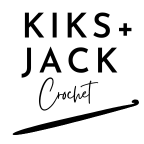
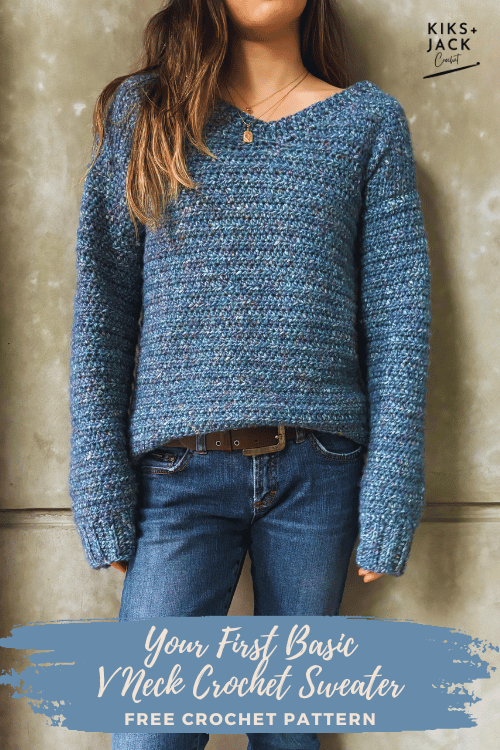

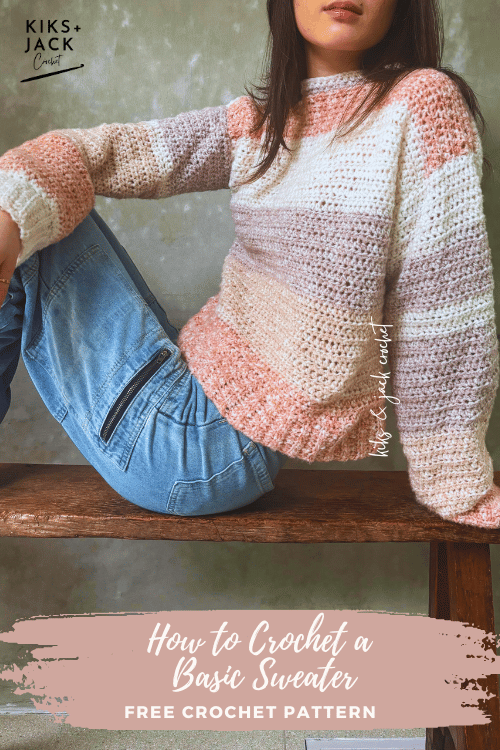
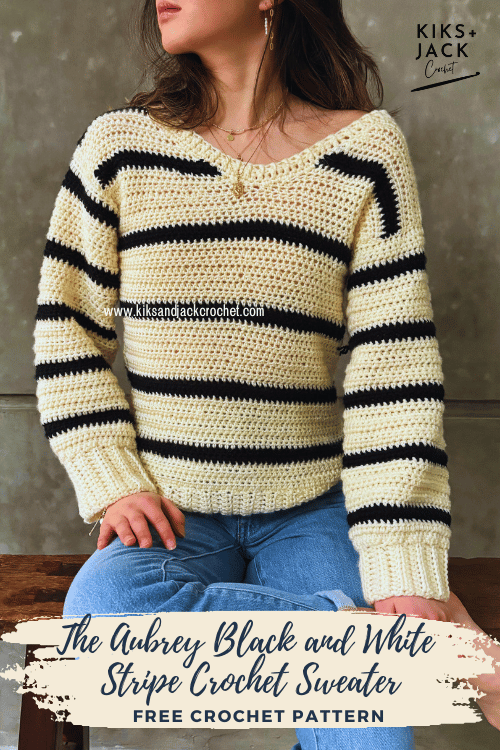
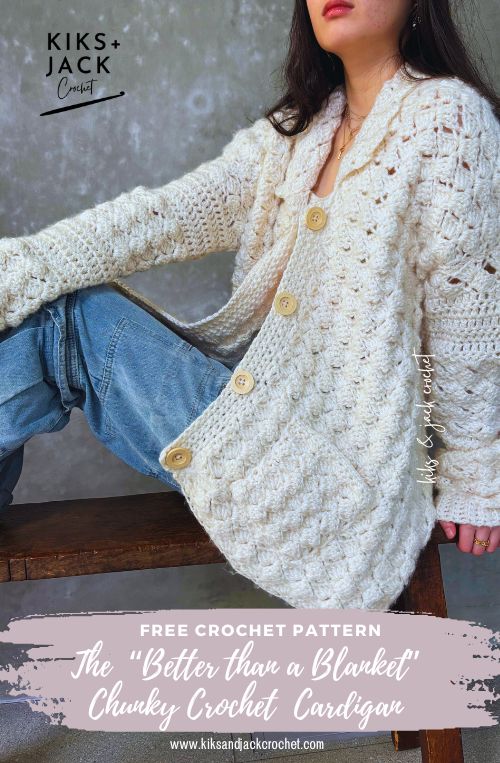
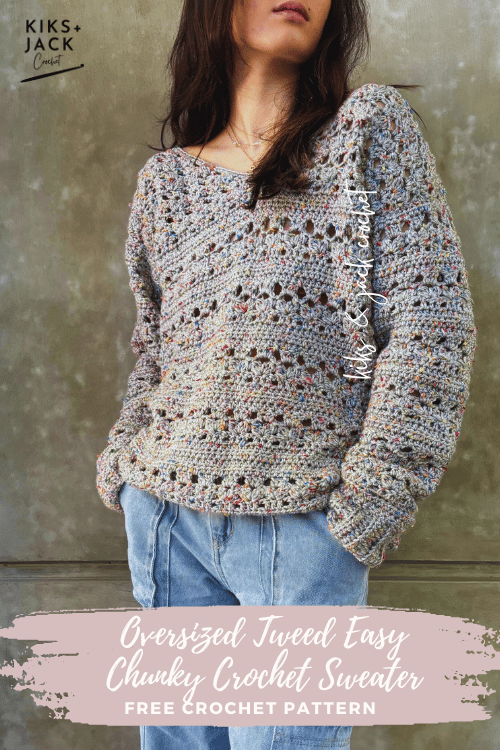
2 thought on “Your First Basic V Neck Crochet Sweater Free Pattern”
Comments are closed.